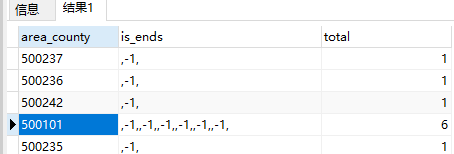postgresql相关sql集锦
1、类似于oracle的listagg->string_agg
SELECT
area_county,','||string_agg(to_char(is_end,'9'),',,')||',' is_ends,count(1)total
FROM
project_info
GROUP BY area_county
注意:
string_agg的第一个参数一定是字符类型,第二个参数是分隔符。
to_char函数是将数字类型的数据转换为字符类型,第一个参数是要转换的数据,第二个参数是转换的格式。
(对于to_char相关说明可以参考:https://www.postgresql.org/docs/10/functions-formatting.html)
结果:

2、统计某个字符在指定字符串中出现的次数。
select array_length(regexp_split_to_array(',-1,,-1,,-1,,-1,,-1,,-1,',',-1,'),1)-1 total
注意:
regexp_split_to_array函数的第一个参数是源字符串,第二个参数是要统计的字符。
结果:

3、树级结构的数据查询(根据父级目录查询所有的子目录)
with RECURSIVE tpath AS( select catalog_id, order_index, parent_id, catalog_name,(catalog_name::varchar(1024))as path from dir_catalog <where> and is_delete = ${dto.isDelete} <choose> <when test="0 != dto.catalogId"> and catalog_id = #{dto.catalogId} </when> <otherwise> and catalog_id in( select catalog_id from dir_catalog where parent_id = ${dto.catalogId}) </otherwise> </choose> </where> union all -- 联合子节点 select b.catalog_id, b.order_index, b.parent_id,b.catalog_name, (tpath.path || '/' || b.catalog_name)::varchar(1024) as path from ( select a.catalog_id, a.order_index, a.parent_id,a.catalog_name,a.is_delete from dir_catalog a where a.app_id = #{dto.appId} and a.catalog_name like concat('%',#{dto.catalogName},'%'))b inner join tpath on b.parent_id = tpath.catalog_id and b.is_delete = ${dto.isDelete} ) select catalog_id, order_index,catalog_name, parent_id, path FROM tpath where catalog_name like concat('%',#{dto.catalogName},'%') order by parent_id,path,order_index limit #{pageSize} offset #{pageNo}
4、懒加载查询根节点和叶子节点,并标识根节点的子节点个数
select catalog_id, null resource_id, catalog_name as name,1 isCatalog,order_index,code, (select sum(total) from (select count(*)total from dir_catalog where parent_id = dc.catalog_id and is_delete= ${isDelete} union all select count(*)total from dir_resource where catalog_id = dc.catalog_id and is_delete= ${isDelete}) as dctdrt)totalChildren,is_publish from dir_catalog dc where parent_id = #{parentId} and app_id = #{appId} and is_delete = ${isDelete} union all select catalog_id,resource_id,resource_name as name,0 isCatalog,order_index,code,0 totalChildren,is_publish from dir_resource where catalog_id = #{parentId} and app_id = #{appId} and is_delete= ${isDelete}
5、从指定序列中取出指定个数的序号
-- varying:序列名称,integer:返回个数 使用”;“隔开
create function getnextids(character varying, integer) returns character varying language plpgsql as $$ DECLARE str VARCHAR ; DECLARE nextid VARCHAR ; BEGIN str = ''; FOR i in 1..$2 loop nextid = (SELECT NEXTVAL($1)); str = str || nextid || ';' ; END loop; RETURN str ; END ; $$; alter function getnextids(varchar, integer) owner to postgres;
6、postgresql自动更新操作时间(自动更新update_time --名字一定要是update_time)
-- 创建函数
create or replace function upd_timestamp() returns trigger as
$$
begin
new.update_time = current_timestamp(0);
return new;
end
$$
language plpgsql;
-- 创建触发器
create trigger t_table_name before update on log_table_name for each row execute procedure upd_timestamp();
备注:1、自动更新create_time:default ('now'::text)::timestamp(0) with time zone
2、创建表时自动为主键生成序列,则指定主键类型为:SERIAL 即可

